Large Bifold Doors: Everything You Need to Know
Table of Contents
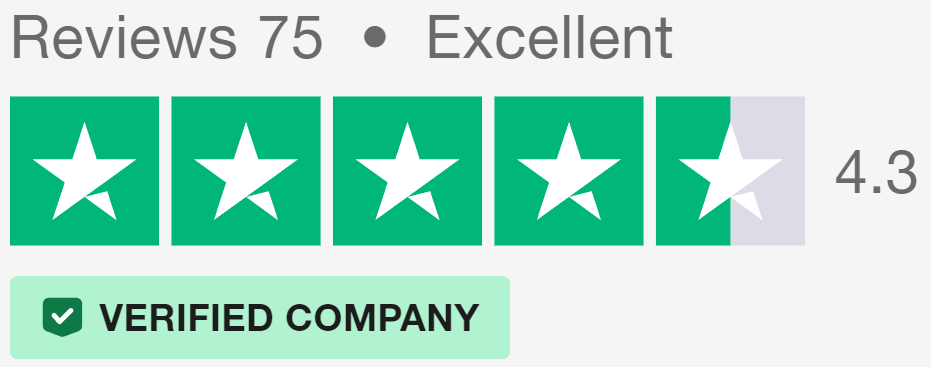
What Are Bifold Doors?
Bifold doors, often referred to as bifolding doors, folding doors, or concertina doors, consist of multiple panels that fold back onto themselves, allowing for wide openings that can span from 3 metres to 10 metres. These doors are particularly suited for large open-plan areas in both residential and commercial settings.
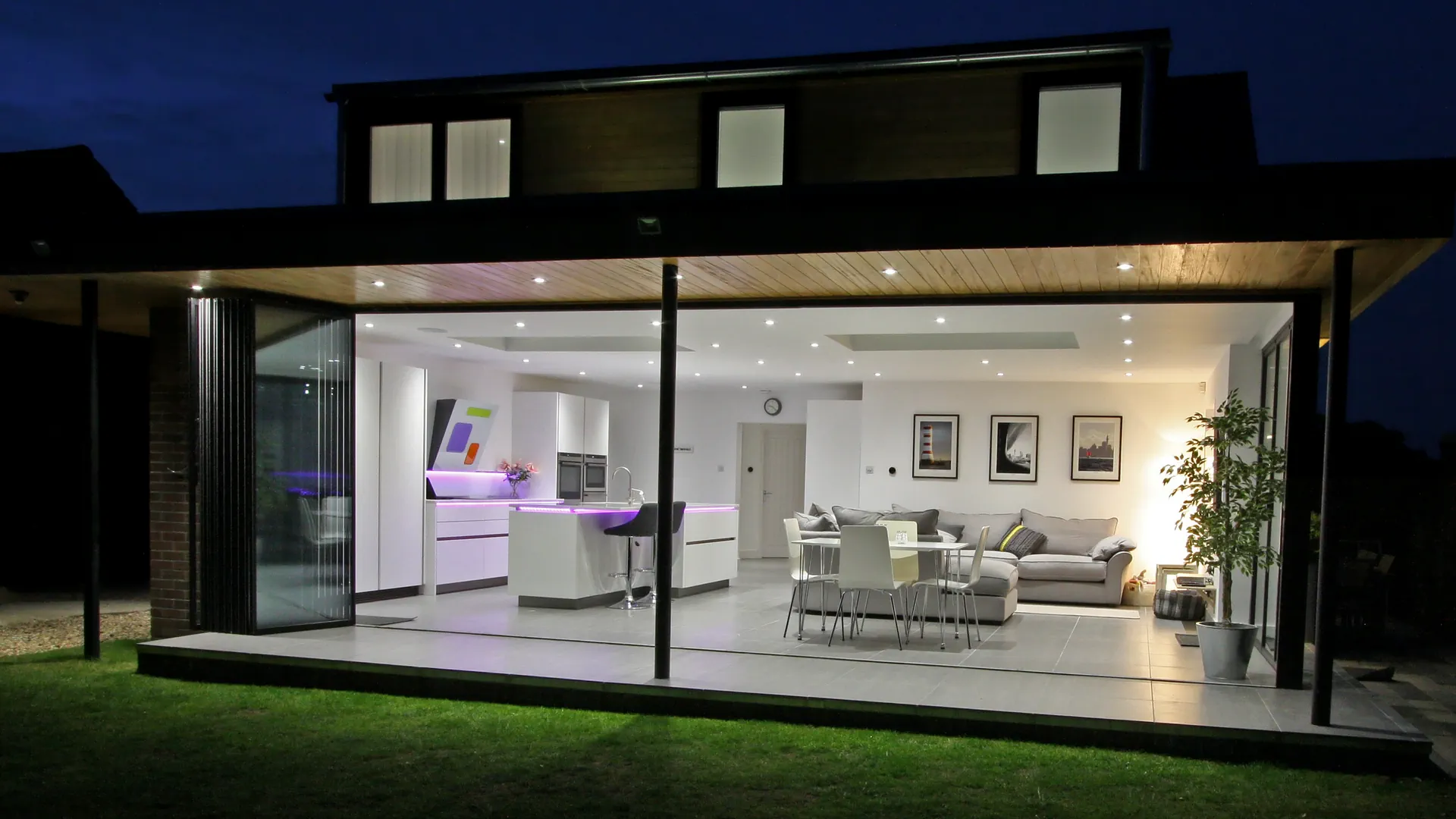
Benefits and Features of Large Bifold Doors
Wide Openings
Bifold doors can be quite wide – some can cover openings up to 10 metres, ideal for large spaces. For example, installing a 6m to 10m bifold door in an open-plan kitchen/living area makes the space much brighter and more inviting for social events such as family gatherings or parties. This also provides an unobstructed view of the garden.Smooth Operation
Despite their size, large folding doors are designed for smooth operation. High-quality tracks and hinges ensure they glide effortlessly, even with frequent use. This reliability is crucial for daily use in busy households or commercial spaces.
Flexible Configurations
Large bifold doors offer various configurations to suit different needs, such as panels that fold inward, outward, or split to stack on both sides. This flexibility allows for creative design solutions. In a commercial setting, for instance, a restaurant could use bifolding doors to open the dining area to an outdoor terrace, providing a versatile dining environment.
Material Choices
Folding doors come in materials like aluminium, timber, and uPVC, each with distinct benefits. Aluminium is strong and requires little maintenance, suitable for exterior applications exposed to the elements. Timber offers a classic look and can be customised with various finishes to match interior décor. uPVC is cost-effective and provides good insulation, which is beneficial for large spaces, helping to reduce energy bills.
Typical Sizes and Their Uses
Common Sizes for Bifolding Doors
Bifold doors come in a range of sizes to accommodate different spaces and needs. Standard sizes typically range from 3 metres to 10 metres in width, with heights up to 3 metres. For residential properties, a 3m to 4m folding door is ideal for smaller openings, such as connecting a living room to a patio. This size provides ample natural light and a clear view of the outdoors without overwhelming the space. On the other hand, larger sizes, such as 6m to 10m doors, are perfect for creating expansive openings in open-plan kitchen and living areas. In commercial settings, large bifold doors are often used in conference rooms, restaurants, and retail areas.Key Benefits and Features
Space Management
Large bifold doors are excellent for managing and optimising space in both homes and commercial buildings. By folding back completely, these doors allow for the creation of vast, uninterrupted openings. For instance, in an open-plan kitchen and living area, a large bifold door can replace a solid wall, making the interior feel more expansive and connected. This is particularly useful during social events or family gatherings, as it allows for easy movement. In commercial settings, such as restaurants, large bifold doors can open up the dining area to an outdoor terrace, effectively doubling the usable space during favourable weather.
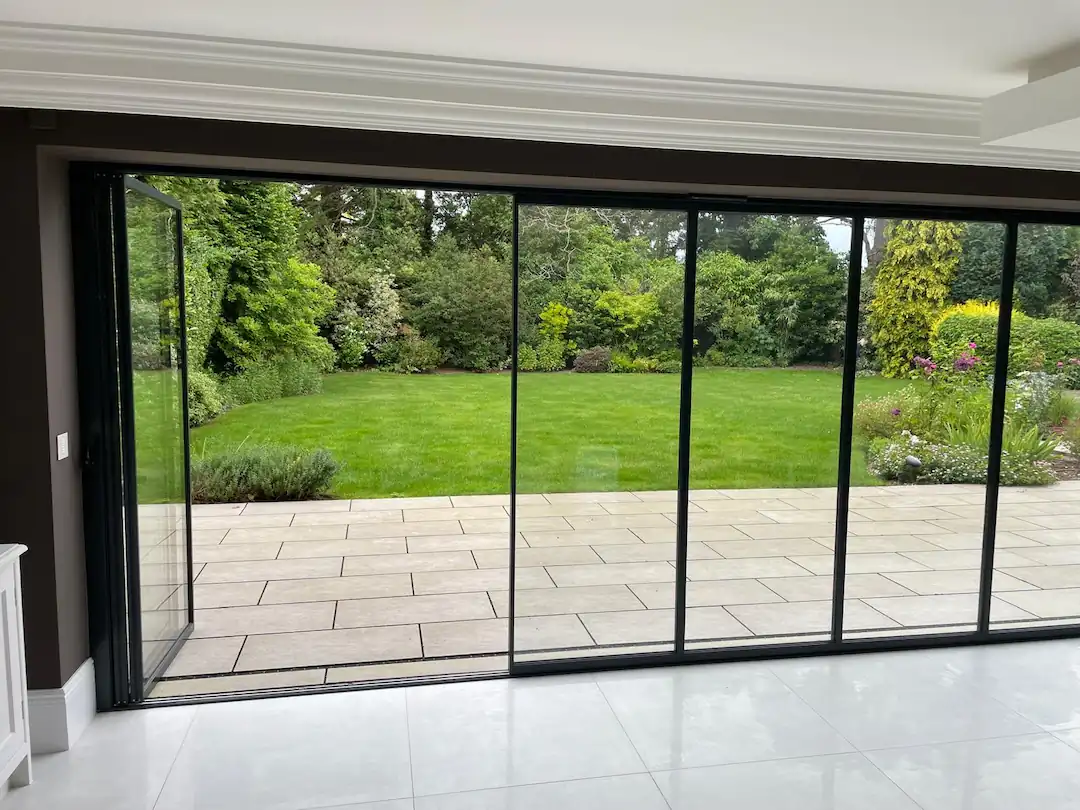
Natural Light
By using glass panels that stretch from floor to ceiling, these doors let in substantial amounts of daylight, reducing the need for artificial lighting during the day. This can create a bright and welcoming atmosphere. For example, a large bifold door in a living room can illuminate the entire space, making it more inviting and comfortable. In an office setting, this can improve the working environment by creating a well-lit, energising space for employees.
Smooth Operation
Despite their size, big bifold doors are designed to operate smoothly and effortlessly. High-quality tracks and hinges ensure that even the biggest doors can be opened and closed with minimal effort. This reliability is crucial for daily use, whether it’s in a busy household or a bustling commercial environment. For instance, a large bifold door leading to a garden should slide open easily, allowing children to play outside without any hassle. In a retail store, staff can quickly open the doors to create an inviting entrance for customers.
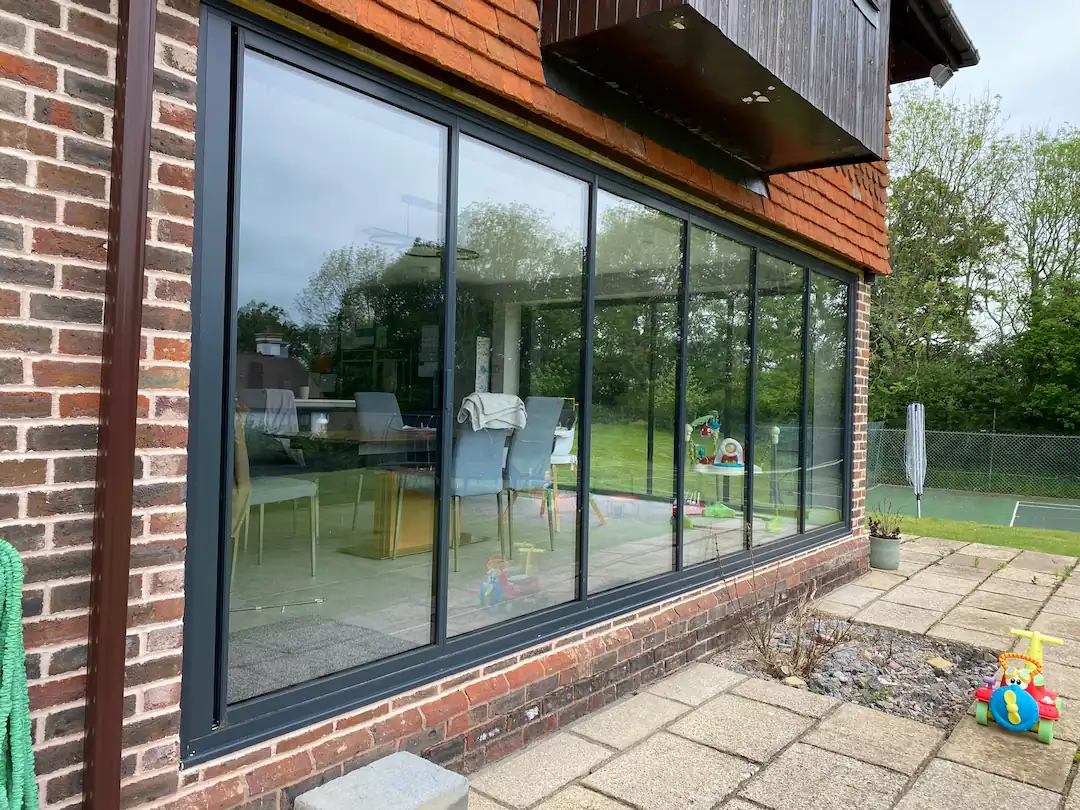
Flexible Configurations
Wide bifold doors offer a variety of configurations to suit different needs and preferences. They can be customised to fold inward, outward, or split to stack on both sides, providing flexibility in how the space is used. This adaptability is beneficial for both residential and commercial applications. For example, a homeowner might choose an inward-folding configuration to save patio space, while a business might prefer an outward-folding design to maximise interior room.
Material Choices
Large concertina doors come in several material options, each with its own benefits. Aluminium doors are known for their strength and low maintenance, making them ideal for external applications. Timber doors offer a classic, warm appearance and can be customised with various finishes to match interior décor. uPVC doors are cost-effective and provide good insulation, which is beneficial for reducing energy costs in large spaces. Choosing the right material depends on factors like climate, maintenance preferences, and aesthetic goals.
Customisation Options
Panel Configurations
The doors can be designed to fold inward, outward, or split to stack on both sides. This flexibility allows homeowners to choose a configuration that best suits their space.Glazing Options
Glazing choices include single, double, or even triple glazing, each offering different levels of insulation and soundproofing. For instance, a property located near a busy street might benefit from triple glazing to reduce noise pollution and improve thermal insulation.Finishes and Colours
The doors can be customised with a variety of finishes and colours to match the property’s aesthetic (such as anthracite grey, black, or more vibrant colours). Aluminium doors can be powder-coated in different colours, while timber doors can be stained or painted in a variety of finishes. A business owner looking to match their brand colours can choose a specific powder coat for their aluminium bifold doors.
Installation and Structural Needs
Structural Requirements
Installing bifold doors for large openings requires careful consideration of the structural integrity of your home or building. These doors are significantly heavier than standard doors due to their size and the materials used. As a result, it’s often necessary to reinforce the walls and ensure that the existing structure can support the weight. For instance, if you plan to install extra large internal doors in an older home, you might need to add steel beams or reinforce the existing wooden frame to provide adequate support. This ensures that the doors operate smoothly and do not cause any structural issues over time. Consulting with a structural engineer before installation can help identify any necessary reinforcements and prevent potential problems.Hardware and Mechanisms
The hardware and mechanisms used in large bifold doors are critical to their performance and longevity. High-quality tracks and hinges are essential for ensuring that the doors open and close smoothly.
Tracks: The tracks must be sturdy and precisely aligned to handle the weight of the large panels. Aluminium tracks are commonly used due to their durability and resistance to corrosion. Proper installation of the tracks is crucial to prevent the doors from jamming or sticking.
Hinges: Heavy-duty hinges are necessary to support the large panels. These hinges must be robust enough to handle frequent use without becoming loose or misaligned. Regular maintenance, such as lubricating the hinges, can help ensure their longevity.
Other Hardware: Additional components, such as locks and handles, should also be of high quality to ensure security and ease of use. For example, multi-point locking systems can provide greater security, which is particularly important for large bifold doors used as external doors.
Performance, Durability, and Security
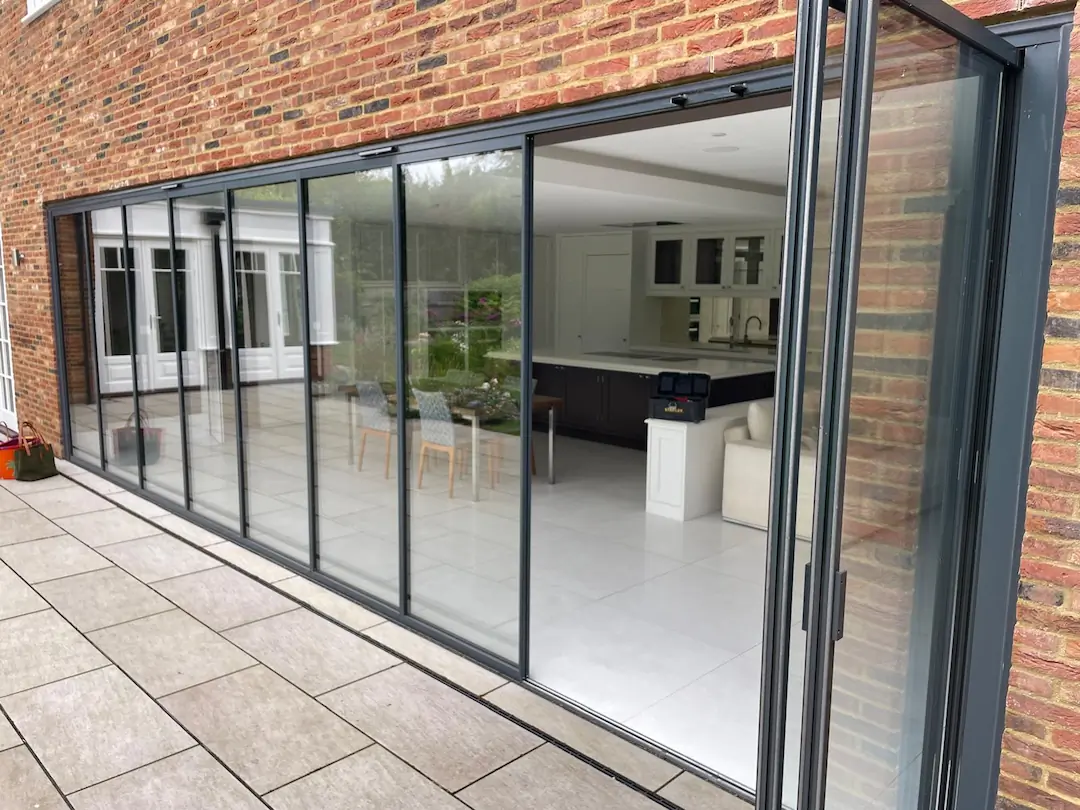
Energy Efficiency
Large bifold doors can have a much bigger impact on energy bills than many would expect, and different materials and glazing options can have a substantial effect on performance. Double or triple glazing can help reduce heat loss, making the home warmer during winter and cooler in summer.How Heat Loss Works
Heat loss occurs when warm air from inside a home escapes to the cooler outside environment. This happens through conduction, convection, and radiation. In the case of bifold doors, conduction through the glass panels and frame is the primary concern. Double and triple glazing work by trapping a layer of air or inert gas between the panes, which acts as an insulator, reducing heat transfer.
Understanding U-Values
A key factor in assessing the energy efficiency of large bifold doors is the U-value. The U-value measures the rate of heat transfer through a building element, such as a door or window, with lower values indicating better insulation. It is expressed in watts per square metre per degree Celsius (W/m²K). A lower U-value means less heat is lost through the door. For exterior doors, look for a U-value under 1.4 for the best long-term value for money.
Impact on Large vs. Small Bifold Doors
The size of the bifold doors matters when considering energy efficiency. Larger bifold doors have a greater surface area, which can result in more significant heat loss if not properly insulated. This makes the U-value even more critical for large bifold doors compared to smaller ones. Homeowners with large bifold doors should opt for doors with low U-values to minimise heat loss and improve energy efficiency. For example, a large bifold door with triple glazing and a U-value of 1.0 W/m²K will retain heat more effectively than a door with double glazing and a higher U-value.
By choosing big bifold doors with low U-values and high-quality glazing, homeowners can reduce heat loss, leading to lower energy bills and a more comfortable living environment. Understanding and prioritising energy efficiency in large bifold doors can make a significant difference in the overall thermal performance of a home.
Weather Resistance
The weather resistance of large bifold doors is crucial, especially in areas with harsh weather conditions. Large aluminium bifold doors are particularly suited for coastal regions where exposure to salty air can cause corrosion. Unlike timber, which requires regular treatment to protect against moisture, aluminium remains resilient and low maintenance. For example, homeowners in seaside towns can benefit from aluminium bifold doors that withstand the elements without frequent upkeep.Security
Multi-point locking systems are highly recommended as they provide several locking points along the door frame, making it much harder for intruders to break in. In areas with higher crime rates, investing in a robust locking system can provide peace of mind. Additionally, opting for doors with toughened glass can add an extra layer of security, making it more difficult for burglars to gain entry. And as with all types of doors, don’t forget to lock them!
Maintenance Tips
Regular lubrication of hinges and tracks can prevent the doors from becoming stiff or difficult to operate. For example, applying a silicone-based lubricant to the tracks and hinges every few months can keep the doors functioning smoothly. It’s also important to clean the tracks regularly to remove any debris that could obstruct the doors’ movement.
Cost and Budgeting
Material Costs
The cost of bifold doors can vary widely depending on the material chosen. Large aluminium bifold doors tend to be more expensive due to their durability and low maintenance. For example, aluminium doors typically range from £1000 to £1800 per metre. Timber bifold doors, while offering a classic and customisable look, can cost between £1500 and £2500 per metre. uPVC doors are generally the most affordable option, costing around £900 to £1200 per metre. When choosing the material, consider both the upfront cost and the long-term maintenance expenses.
Additional Costs
Beyond the cost of materials and installation, there are additional expenses to consider. Structural reinforcements might be needed to support the weight of large bifold doors, particularly in older homes. This can add several hundred pounds to the overall cost. Custom finishes and unique glazing options can also increase the price. For instance, opting for triple glazing or a specialised colour finish can add an extra £200 to £500 per door.
Budgeting Tips
To manage the costs effectively, consider the following budgeting tips:
- Financing Options: Many suppliers offer financing options that allow you to spread the cost over several months or years. This can make it easier to manage the expense without compromising on quality.
- Sales and Discounts: Look out for seasonal sales or promotional discounts from suppliers. Purchasing during these periods can significantly reduce costs. Not all suppliers discount their products, however – particularly smaller ones.
- Standard Sizes: Opting for standard door sizes rather than custom dimensions can help keep costs down. Custom sizes often come with a premium price tag.
- DIY Preparation: Even if you hire professionals for the installation, preparing the site yourself can save on labour costs. This might include removing old doors or clearing the area for the new installation.
- Energy Efficiency Savings: Investing in high-quality glazing can reduce energy bills in the long run, offsetting the initial higher cost of doors with better insulation.
Design Trends
Popular Styles
Bi folding doors are versatile and can fit into various design styles, whether contemporary or traditional. In contemporary settings, minimalist designs with clean lines and large glass panels are popular. These doors often feature sleek frames in colours like matte black or brushed aluminium, which complement modern interiors. For example, a home with a minimalist aesthetic might use large bifold doors with ultra slim aluminium frames.
In contrast, traditional styles often favour timber bifold doors with detailed craftsmanship. These doors can be painted in classic colours like white or natural wood stains. For instance, a cottage-style home might feature timber bifold doors with a natural oak finish, blending seamlessly with vintage furniture and classic décor.
Finishes and Colours
Current trends in finishes and colours for wide bifold doors include a range of options to suit different tastes. Matte black finishes are particularly popular in modern homes, providing a bold contrast to lighter interior palettes. Natural wood finishes remain a favourite for their timeless appeal and ability to add warmth to a space. Homeowners looking to make a statement might opt for bold colours like deep blue or forest green, which can add character and personality to their doors.
Integration with Interior Design
Integrating large bifold doors into your interior design involves careful consideration of colour palettes and furniture placement. Matching the door colour with existing interior colours can create a cohesive look. For example, if your living room features neutral tones, choosing bifold doors in a similar shade can maintain a harmonious aesthetic. Additionally, coordinating the door finish with furniture materials, such as pairing timber doors with wooden furniture, can be effective.
Furniture Placement
Arranging furniture around large bifold doors requires thoughtful planning to maximise space and light. Placing seating areas near the doors can take advantage of the natural light and views. For example, positioning a sofa and coffee table adjacent to the bifold doors can create a cosy yet open living area. In dining rooms, placing the table close to the doors can make the room feel more connected to the outdoor environment, perfect for al fresco dining when the doors are open.
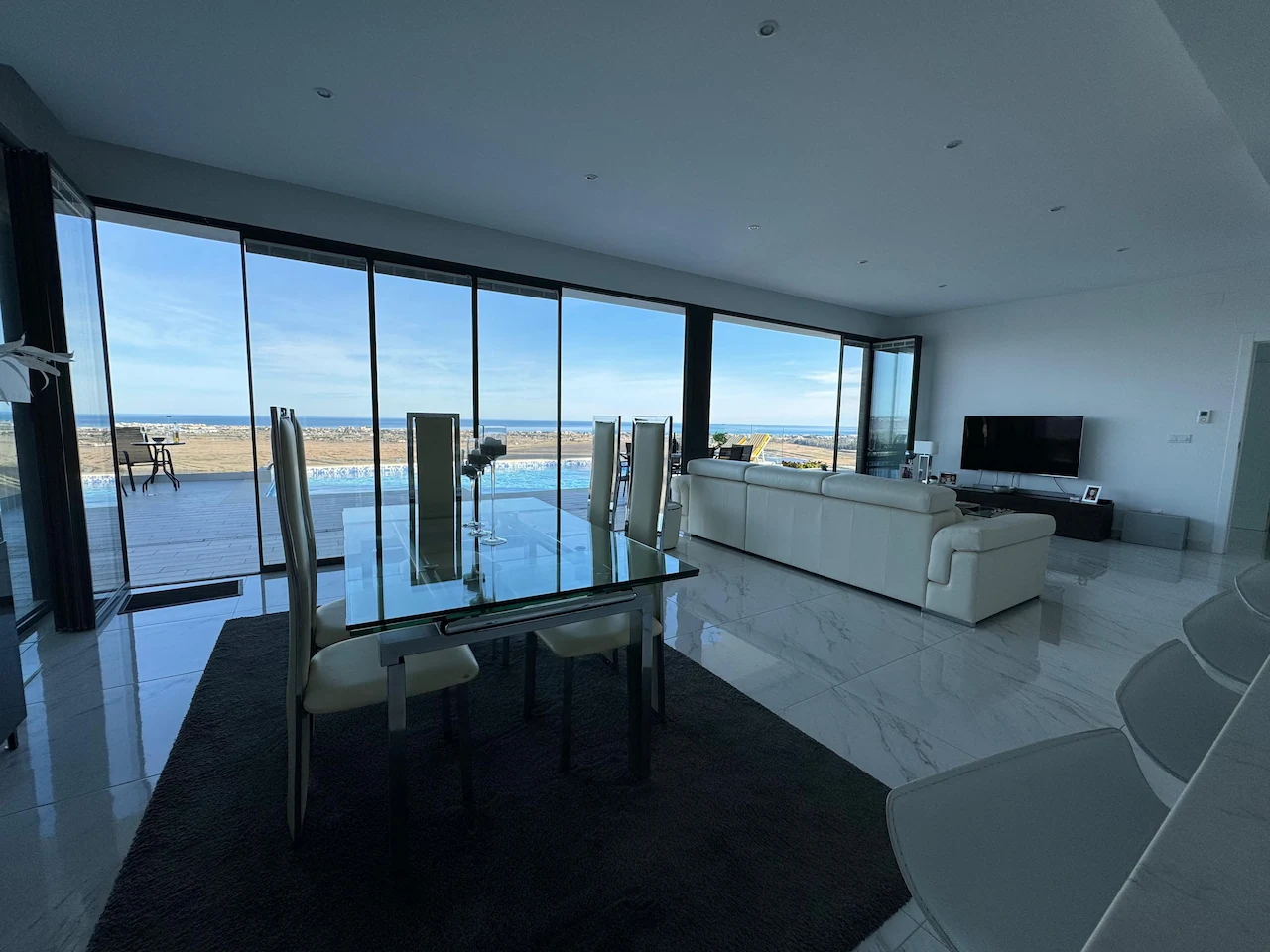
Comparison with Other Large Door Options
Functionality Comparison
Large bifold doors, also known as large concertina doors, can open up an entire wall. In contrast, sliding doors typically open only halfway, as one panel slides over the other. For example, in an open-plan kitchen, large bifold doors allow for unobstructed access to a garden or patio, making it easier to host outdoor gatherings and move between areas.
Visual Comparison
Large glass bifold doors provide a modern and sleek appearance, with minimal framing and maximum visibility. They are ideal for contemporary homes that favour clean lines and open spaces. Taking this a step further, we even offer completely frameless doors which are ideal for large openings. French doors, on the other hand, often have more traditional designs with multiple panes of glass and ornate frames, which can add a touch of classic elegance to a living room. Choosing between the types depends largely on the overall style of the home and the desired visual effect.
Space Management
Large bifold doors can save room space compared to sliding doors, especially in smaller areas. For instance, in a compact living room, extra wide bifold doors can be folded neatly to one side, freeing up space that would otherwise be occupied by the fixed panel of a sliding door. This makes bifold doors a versatile option for both small and large spaces, as they provide flexibility in how the space is used.
Frequently Asked Questions
What should I consider regarding the weight of large bifold doors?
Large bifold doors are significantly heavier than standard doors due to their size and the materials used. When planning installation, it is crucial to ensure that the structural support is adequate. This may involve reinforcing the door frame or consulting with a structural engineer. The weight also affects the choice of hardware; robust tracks and hinges are essential to handle the load and ensure smooth operation. For instance, a typical large aluminium bifold door set will require heavy-duty hinges to prevent sagging and ensure longevity.
What building regulations apply to installing large bifold doors?
In the UK, installing large bifold doors must comply with building regulations to ensure safety and energy efficiency. Key aspects include structural integrity, thermal performance, and ventilation. For instance, Part L of the building regulations covers the conservation of fuel and power, ensuring that doors provide adequate thermal insulation. It is important to have a certified installer who understands these regulations to avoid any compliance issues.
Are there specific energy efficiency certifications for large bifold doors?
Yes, large bifold doors can be certified for energy efficiency by organisations like the British Fenestration Rating Council (BFRC). The BFRC rating system measures the energy performance of windows and doors, with A++ being the highest rating. For example, choosing bifold doors with a high BFRC rating can ensure better thermal efficiency, reducing heating bills and improving comfort within the home.
What security certifications should large bifold doors meet?
Large bifold doors should meet security standards such as PAS 24, which sets the minimum requirements for enhanced security performance. This certification ensures that the doors can withstand various types of forced entry attempts. For example, bifold doors with multi-point locking systems and toughened glass are often certified to PAS 24 standards, providing homeowners with peace of mind regarding security.
When is planning permission required for installing bifold doors?
In most cases, replacing existing doors with bi folding doors does not require planning permission. However, if the installation involves making significant changes to the structure of the building or if the property is listed or located in a conservation area, planning permission may be needed. It is advisable to check with the local planning authority to ensure compliance. For instance, installing extra wide bifold doors in a listed building would likely require special permissions.
We’d Love to Help You
At Vision Glass Doors, we specialise in designing, manufacturing, and installing premium large bifold door systems. As a family-run business with over 20 years of experience and more than 5,000 installations across the UK, we pride ourselves on our expertise and dedication to quality.
Our large bifold doors undergo rigorous security testing and have successfully passed the PAS-24 certification, a legal requirement for all new-build homes. This ensures that our doors provide the highest levels of security and peace of mind.
Each of our large bifold doors is made to measure, designed, and fabricated at our manufacturing facility in Luton, Bedfordshire. We offer professional installation services within a 100-mile radius, ensuring a perfect fit and finish for your project.
Our extensive range of door systems include Ultra Slim – Slide and Turn Doors, Slimline Sliding Patio Doors and Frameless Glass Doors. Suitable for various internal and external applications, they are applicable to residential and commercial projects.
Please click Quick Quote Online for a free quotation within 24 hours. Alternatively, call or email us on 01582 492730 or at info@visionglassdoors.co.uk.

